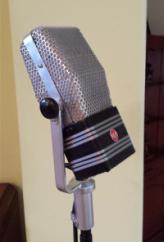RCA-44BX Replica Microphone Project
The RCA-44BX bi-directional ribbon-element microphone was the dominant microphone used by the radio network studios and local radio station studios throughout the United States from the mid 1930s through the early 1950’s. The bi-directional pattern allowed two people to use the mic at the same time – one on each side. This enabled fewer of the expensive microphones to be used in the limited audio facilities in sound studios. Sound studios were carefully constructed to limit reverberation and outside noises so actors and announcers did not need to work the mic at the close distances frequently used today. As a result of the ribbon element and high quality transformer inside, this mic provided exceptional sound quality for both speech and musical instruments. However, the ribbon mic is highly susceptible to wind and close talking effects as well as vibration but were not problems in a well run and engineered studio. As a result the 44BX was rarely used outside or in stage situations where aural feedback could be a problem.
.jpeg)
.jpeg)
.jpeg)
_B.jpg)
.jpeg)
.jpeg)
.jpeg)
To this day, professional sound recording studios search out this
specific microphone, or similar but very expensive replicas, for
certain vocal and instruments for their warm and clean sound. While
they can be found on the Internet the cost can be so high that only
the serious collector will invest in the 44BX whether working or
not. Replicas with similar performance characteristics are also very
expensive with only high-end recording studios investing in what
would normally be considered a fragile and limited use instrument.
But these studios and some artists still recognize the situations
where the 44BX is still the best mic for the job.
RCA has not made these microphones since the end of the run in the
early 1950s. While they brought out other versions – the 77D and
44Jr and the BK-7 and a handful of others – none have the desirable
aural characteristics as the 44BX. On the other hand it was the
iconic shape and general appearance (diamond shape) of the 44BX that
was included with most radio performers in publicity photos and
cemented the image of the 44BX in the memories of radio listeners
around the world and they associate it with the Golden Age of Radio
(1930-1955).

.png)
.jpg)

Because of their scarcity, the RCA-44BX, while in high demand for
old-time radio re-enactment groups and performers have had to fall
back to another “retro” mic – the Shure 55. It was often called the
“Elvis mic” or the “Sinatra mic” because so many publicity photos
showed the 55 when used on famous stages. Shure, to their credit,
reissued at a reasonable cost, the famous “unidyne” or “cardioids”
pattern model 55 as a “2nd edition” microphone complete with higher
performance microphone element but with the identical design. As a
result any singer or group that wants to project a retro image will
likely use one or more of the Shure 55 mics. Interestingly, the 55
was rarely used inside radio or sound studios but was popular for
stage use because of the cardioid pattern.
So, in order to complete the image of old-time radio re-enactments,
it was necessary to have, if not a genuine but hugely costly
RCA-44BX, a replica of that famous microphone. In The Villages in
central Florida, the Old-Time Radio Drama Club commissioned a
modeler, John Manion, to make several of these microphones. The result was a
stage-worthy replica which, when a decent ribbon microphone was
installed inside to make it operational and not just a prop, became
an instant hit with performers and audiences alike.
.jpg)
.jpg)
.jpg)
.jpg)
.jpg)

See the October 8, 2017 article by Joe
Pedersen in The Daily Sun about John Manion and the making of the
replica microphone
HERE.
###
